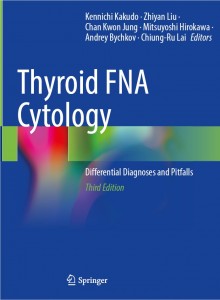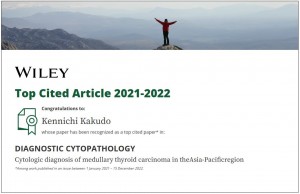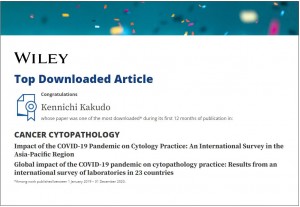To Clinician
AOTA Bali and the University of Indonesia Residency Program
2024/06/02
The Asian Thyroid Working Group conducted a symposium in the AOTA Bali held on May 23rd, 2024. Dr. Liu, Hang, Jung and Bychkov jointed it as speakers and Dr. Lai and I chaired it (Fig. 1)
. In a same time the Department of Pathology, University of Indonesia invited us for lectures before and after the AOTA meeting. I had an opprtunity to deliver my lecture on overdiagnosis and overtreatment of cancer together with Dr. Tsujinaka (Fig. 2).
category: To Clinician , To pathologist comment: (0)
Thyroid FNA Cytology, Differential Diagnoses, and Pitfalls
2024/03/03
I am delighted to announce that my book “The 3rd Edition, Thyroid FNA Cytology: Differential Diagnoses and Pitfalls” has just been published online (https://link.springer.com/book/10.1007/978-981-99-6782-7) .
I found that the diagnostic criteria of malignancy by pathologists and clinical guidelines varied greatly from country to country. Asian thyroid nodule practice necessitates adaptation under diverse conditions, such as diverse healthcare resources, health insurance coverage, social policies, and epidemiological differences. They were crystallized in textbooks, the first and second editions of The Thyroid FNA Cytology: Differential Diagnoses and Pitfalls, highlighting how thyroid nodule practice is handled differently in Asian countries.
I wish to introduce the unique textbook Thyroid FNA Cytology: Differential Diagnoses and Pitfalls, published recently in its third edition from Springer, Singapore. This textbook helps endocrinologists, endocrine surgeons, radiologists, pathologists, and cytopathologists understand our diversity in thyroid nodule practice. To provide individualized guides to readers practicing in various geographic areas with different medical settings and social resources, the third edition tries to cover more than those provided by the first and second editions and invites authors from 21 countries in 95 chapters.
The Thyroid FNA Cytology, Differential Diagnoses, and Pitfalls have intentionally provided several topics in duplicate chapters by different authors to show how they are handled differently so that readers may select the most suitable and appropriate one related to each reader’s thyroid practice and FNA cytology. I hope readers will enjoy reading these topics and compare their differences, as in any other existing textbooks on thyroid FNA cytology focusing on only one country. Understanding others is thought-provoking and can provide surprises on how thyroid FNA cytology is operated on differently among countries. I believe that this approach can increase knowledge and broaden perspectives.
category: To Clinician , To pathologist comment: (0)
Wiley Top Cited Article 2021-2022
2023/02/23
Willey contacted me recently and I found one of our group studies published in the Diagnostic Cytopathology (Cytological diagnosis of medullary thyroid carcinoma in the Asia-Pacific region.) was selected as a top cited article in 2021-2022. Congratulation to the first name author, Dr. C-Y Liu, and thanks to the Asian Working Group on Thyroid Cytology/Pathology. Those group works are productive and there are more than 20 publications by our group since 2017. We found significant heterogeneity in methodologies of thyroid cytology, but fair high diagnostic accuracy in this rare thyroid carcinoma in Asian-Pacific region.
.
category: To Clinician , To pathologist comment: (0)
Top 10 Most Downloaded Papers by Wiley
2022/06/17
It is good news for us. Our 2 papers on COVID19 impacts on cytology lab published in Cancer Cytopathology were selected for the Top 10 Most Downloaded papers by Wiley. Thanks for these two international collaborations.
category: To Clinician , To pathologist comment: (0)
Focused Issue published in the Gland Surgery
2020/11/13
The Gland Surgery published a focused issue, “Asian and Western practice in thyroid pathology: similarities and differences.” It is open access and available at a link: http://gs.amegroups.com/post/view/asian-and-western-practice-in-thyroid-pathology-similarities-and-differences
Your comments are welcome.
category: To Clinician , To pathologist comment: (0)







